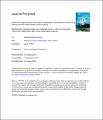Enhanced nitrogen removal of low carbon wastewater in denitrification bioreactors by utilizing industrial waste toward circular economy
Kiani, S., Kujala, K., Pulkkinen, J., Aalto, S. L., Suurnäkki, S., Kiuru, T., Tiirola, M., Kløve, B., & Ronkanen, A.-K. (2020). Enhanced nitrogen removal of low carbon wastewater in denitrification bioreactors by utilizing industrial waste toward circular economy. Journal of Cleaner Production, 254, Article 119973. https://doi.org/10.1016/j.jclepro.2020.119973
Published in
Journal of Cleaner ProductionAuthors
Date
2020Copyright
© Elsevier Ltd.
Aquaculture needs practical solutions for nutrient removal to achieve sustainable fish production. Passive denitrifying bioreactors may provide an ecological, low-cost and low-maintenance approach for wastewater nitrogen removal. However, innovative organic materials are needed to enhance nitrate removal from the low carbon effluents in intensive recirculating aquaculture systems (RAS). In this study, we tested three additional carbon sources, including biochar, dried Sphagnum sp. moss and industrial potato residues, to enhance the performance of woodchip bioreactors treating the low carbon RAS wastewater. We assessed nitrate (NO3−) removal and microbial community composition during a one-year in situ column test with real aquaculture wastewater. We found no significant differences in the NO3− removal rates between the woodchip-only bioreactor and bioreactors with a zone of biochar or Sphagnum sp. moss (maximum removal rate 31–33 g NO3−-N m−3 d−1), but potato residues increased NO3− removal rate to 38 g NO3−-N m−3 d−1, with stable annual reduction efficiency of 93%. The readily available carbon released from potato residues increased NO3−-N removal capacity of the bioreactor even at higher inflow concentrations (>52 mg L−1). The microbial community and its predicted functional potential in the potato residue bioreactor differed markedly from those of the other bioreactors. Adding potato residues to woodchip material enabled smaller bioreactor size to be used for NO3− removal. This study introduced industrial potato by-product as an alternative carbon source for the woodchip denitrification process, and the encouraging results may pave the way toward growth of blue bioeconomy using the RAS. ...
...
 ...
...
Publisher
ElsevierISSN Search the Publication Forum
0959-6526Keywords
Publication in research information system
https://converis.jyu.fi/converis/portal/detail/Publication/33986388
Metadata
Show full item recordCollections
Related funder(s)
Research Council of FinlandFunding program(s)
Others, AoFAdditional information about funding
This study was funded by the Maa- ja vesitekniikan tuki ry. [grant no. 37413], Natural Resources Institute 467 Finland (LUKE), KAUTE-Säätiö and Olvi-säätiö, and by the European Union BONUS Blue Baltic (Art 185) 468 CLEANAQ project partly funded by the Academy of Finland [grant no. 311984]License
Related items
Showing items with similar title or keywords.
-
Salinity affects nitrate removal and microbial composition of denitrifying woodchip bioreactors treating recirculating aquaculture system effluents
von Ahnen, Mathis; Aalto, Sanni L.; Suurnäkki, Suvi; Tiirola, Marja; Pedersen, Per Bovbjerg (Elsevier BV, 2019)This study investigated the effect of salinity on microbial composition and denitrification capacity of woodchip bioreactors treating recirculating aquaculture system (RAS) effluents. Twelve laboratory-scale woodchip ... -
Microbial communities in full-scale woodchip bioreactors treating aquaculture effluents
Aalto, Sanni L.; Suurnäkki, Suvi; von Ahnen, Mathis; Tiirola, Marja; Bovbjerg Pedersen, Per (Elsevier Ltd., 2022)Woodchip bioreactors are being successfully applied to remove nitrate from commercial land-based recirculating aquaculture system (RAS) effluents. In order to understand and optimize the overall function of these bioreactors, ... -
Nitrate removal microbiology in woodchip bioreactors : a case-study with full-scale bioreactors treating aquaculture effluents
Aalto, Sanni L.; Suurnäkki, Suvi; von Ahnen, Mathis; Siljanen, Henri M. P.; Pedersen, Per Bovbjerg; Tiirola, Marja (Elsevier, 2020)Woodchip bioreactors are viable low-cost nitrate (NO3−) removal applications for treating agricultural and aquaculture discharges. The active microbial biofilms growing on woodchips are conducting nitrogen (N) removal, ... -
Discharge management in fresh and brackish water RAS : Combined phosphorus removal by organic flocculants and nitrogen removal in woodchip reactors
Kujala, Kukka; Pulkkinen, Jani; Vielma, Jouni (Elsevier, 2020)The current study combined P and N removal using organic flocculant chemicals and woodchip bioreactors in both freshwater and brackish water (7 ppm) recirculating aquaculture systems (RAS). The use of carbon (C) containing ... -
Filtration of Nordic recirculating aquaculture system wastewater : Effects on microalgal growth, nutrient removal, and nutritional value
Calderini, Marco L.; Stevčić, Čedomir; Taipale, Sami; Pulkkinen, Katja (Elsevier, 2021)Microalgal bioremediation of recirculating aquaculture system (RAS) wastewater represents an alternative for wastewater treatment with the potential to generate valuable biomass. This study evaluated the effects of removing ...

